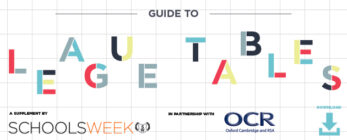To download the guide click here (9mb).
The focus in all schools is rightly on the young people sitting in classrooms, working hard each day, to try and learn all they can. It’s noble to believe they do it because it’s fun and intrinsically good. Learning really is those things, but there’s also an extent to which students work so that they can gain qualifications. Not because they are hungry for certificates to stick on their walls, but because qualifications are passes to the future.
For that reason, school leaders who work with young people at key stage 4 and 5 pay attention to who is passing what.
There’s another reason, too. In all bluntness, the reputation of the school – and the jobs of people within it – often hangs on the numbers of students passing certain exams or qualifications. The reasons for this are explored intricately over the next few pages; but whatever the past says about why, the fact is that performance measures for schools now matter and school leaders cannot pretend they don’t know about or understand them.
Which doesn’t mean the government makes it easy to follow what you’re supposed to do. In the past few years there has been endless tinkering with what does and doesn’t count in league tables; how many times a student can enter; the double or triple or zero weighting of a subject in a ‘basket of goods’ – and so on.
This interminable vocabulary has become so dense that we decided it was time to gen up on all the difficult bits and then lay them out, clearly, once and for all, in an easy-read guide of what you can expect in the coming year as the league tables change for key stages 4 and 5.
Working with writers from LKMCo, an education think and action tank, we have created a guide that takes you through the history of the changes, breaks down what they mean, provides case studies of the decisions that schools are making – and does it all in a glossy, well-designed way.
We hope that you will read it, keep it and use it again and again. Perhaps even study it. If not for its intrinsic worth, at least because everyone needs to know about how qualifications will affect their future – whether they are a child, or a school leader.










There appears to be an error in the Progress 8 example for Gillian (p17). Her ‘other’ qualifications should be QA3 (6), QA5 (5) and QA7 (5).
Also typo in bottom table on p.17 (‘busniess’)
and also on p23 in the Uplands case study there is reference to OCR Cambridge Nationals as suitable qualifications. Note that only some Cam Nats made it onto the list of qualifications that count in the 2017 performance tables. Cam Nats ICT did not and it is a course offered widely by schools. (http://www.ocr.org.uk/news/view/update_on_dfe_2017_performance_tables/)